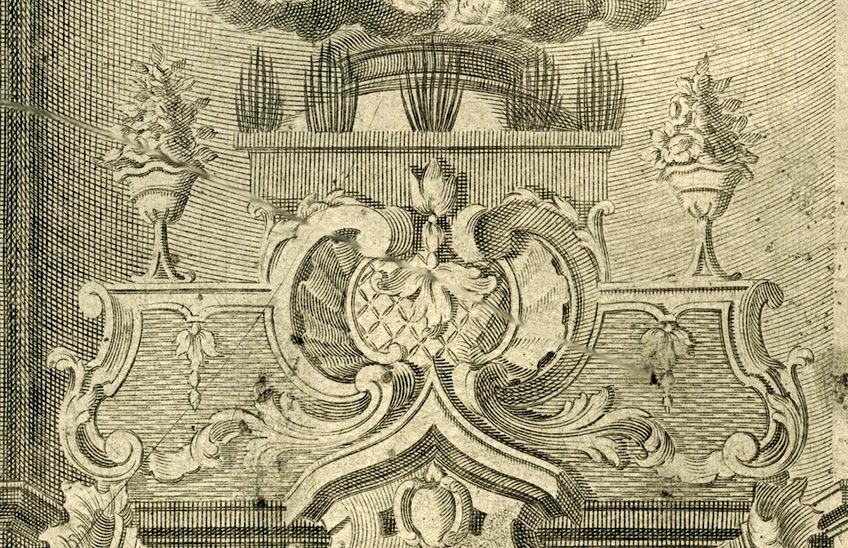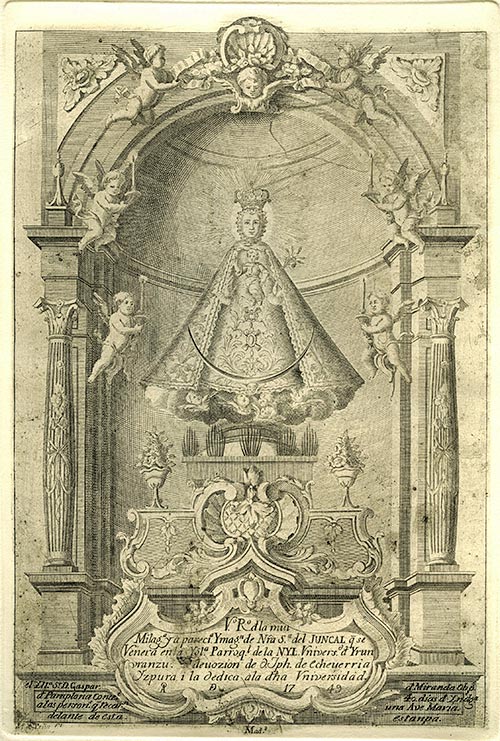An engraving from 1749 of the Virgen del Juncal de Irún, by Juan de la Peña.

PhotoCedit/Detailof the engraving of the Virgen del Juncal de Irún, by Juan de la Peña, 1749. Private Collection
The history of this print, like that of many others, has scarcely been published. We will try to make some contributions for a better understanding of it knowledge. With regard to the author who signature as Js a Peña, we must identify him, given the quality of the piece, with Juan de la Peña, also known as Juan Fernández de la Peña (Salamanca, 1729 - Mexico, 1774), who trained in the city of Tormes with the Sicilian engraver Lorenzo Monteman y Cusens. He moved to Madrid in 1747, the year in which he competed with his fellow student Tomás Prieto for the post of principal engraver at the Madrid Mint. In 1758 he travelled to Mexico, where he was the first engraver at the Casa de la Moneda. He worked in various genres and also devoted himself to book illustration.
We only know that the promoter of the engraving, José de Echeverría Yzpura, was a judge of the scales and that he was married to María Aguado Muñoz, who, when she was widowed in 1765, asked for the pension she was entitled to. Everything indicates that the promoter and engraver must have known each other in the environment of the Mint, where Echeverría was the judge of the scales, in charge of weighing the gold, silver and metals which arrived and left the institution. The judge of the scales had to keep a strict control of the metals, which is why a person of great skill, expertise and intelligence in the handling of weights, weights and scales of different sizes was always chosen.
As on other occasions, we find a son of a locality who rises socially and commissions the plate to print engravings of the great devotion of his hometown, in this case Our Lady of Juncal de Irún. As on other occasions, the generous donor did not limit himself to simply commissioning the plate, but his devotion to the image led him to found a chaplaincy endowed with the significant sum of 4,500 ducats in 1763, the documentation for which is preserved at file Diocese of Pamplona.
The image depicted belongs to the 12th century and is considered, together with that of Itziar, to be the oldest in Guipúzcoa. In the print, she is depicted in the Baroque style, as a dresser, with an apron and funnel-shaped cloak. She wears jewellery, a crown and a small rostrum. At her feet are the reeds that give rise to the legendary account of her appearance. The rococo niche, with two columns with adventitious plaques, is dotted with ceroferary angels and others at the top. In the lower part there is a cartouche with a long registration with the data displayed and the usual indulgences of a bishop who, by the way, was very fond of having devotional prints made, Don Gaspar de Miranda y Argáiz, who held the mitre of San Fermín between 1742 and 1767.
The legend of this Marian invocation includes its special protection over sailors and cripples, as well as its finding in the reed beds of an arm of the sea that goes up from Higuer in Fuenterrabía to Irún, in the same place where its temple currently stands. The image was transferred to the latter from a smaller one, located higher up and to which she was taken when she appeared. To the sanctuary they came from France in pilgrimage and seven towns of the region in procession every year, the day of the eve of the Ascension, something that was stopped in obedience to the Synodal Constitutions of Pamplona of 1590, which forbade to walk more than average distance for those devotional and festive practices. Its text reads as follows: Vº Rº de la mui / Milagª y apareciª Ymagn de Nra Sª del JUNCAL q se / Venera en la Iglª Parroql de la MNL Universd de Yrun / vranzu a devoción de D. Jph de Echeverría / Yzpura i la dedica a la dha Universidad. / A D 1749 / El Yllº Sr D Gaspar de Miranda Obpº / d Pamplona conce 40 días d Yndulgª / a las persons q rezarn una Ave Maria / delante de esta estanpa. Js a Peña ft Madd. The measures of the plate are 282 x mm. and those of the stamp 385 x mm.

Engraving of the Virgin of Juncal de Irún, by Juan de la Peña, 1749. Private Collection
Coinciding with the date of the engraving, the cult of the image must have experienced a great increase development, as can be seen from test the novena to celebrate her feast which was dedicated to her by the presbyter Juan Francisco Navarte in August 1755 and which we know from the 1847 edition, produced in San Sebastián in the printing house of Ignacio Ramón Baroja. In 1754 the great altarpiece that presides over the parish church was gilded, project in which many local children collaborated. The Count of Fabraquer, in the third volume of his monograph on the Virgins that have appeared in Spain, refers to the religious and recreational festivities that were held in her honour in the 19th century.
A master painter from Quito -José Cortés y Alcocer- used this engraving as source graphic for a canvas of the Virgen del Juncal with the portrait of Captain Joaquín Elorrieta as the donor. The painting belonged to the Roberta and Richard Huber Collection in New York and was donated to the Philadelphia Museum of Art in 2012. Although the programs of study of this painting is quotation the source in the engraving in question, the latter is always catalogued as anonymous, as only the print cut out at the bottom is known.
The print does not appear in any repertoire or collection; we have only found it cropped and, therefore, without the name of its author in the Antonio Correa Collection in Calcografía Nacional (Real Academia de Bellas Artes de San Fernando).
To find out more
CEÁN BERMÚDEZ, J. A., Diccionario histórico de los más ilustres profesores de las Bellas Artes en España, vol. IV, Madrid, Imprenta de la Viuda de Ibarra, 1800.
Devoción y modo de hacer la novena a Ntra. Sra. María Santísima Madre de Dios del Juncal, San Sebastián, Ignacio Ramón de Baroja, 1847. signature the dedication in Irún on 26 August by Don Juan Francisco Navarte "his most devoted and favoured son and chaplain".
MATILLA TASCÓN, A., Índice de expedientes de funcionarios públicos. Widowhood and orphanhood. 1763-1872, Madrid, Hidalguía, 1962.
PÁEZ RÍOS, E., Repertorio de grabados españoles en la Library Services Nacional, vol. II, Madrid, Ministry of Culture, 1982.
STRATTON-PRUITT, S. L., "El arte virreinal hispanoamericano en las colecciones estadounidenses", in Ortiz Crespo, A., Arte quiteño más allá de Quito, Quito, Fonsal, 2010.
STRATTON-PRUITT, S. L., Journeys to New Worlds: Spanish and Portuguese Colonian Art in the Roberta and Richard Huber Collection, Yale University Press, 2013, no. 30.
